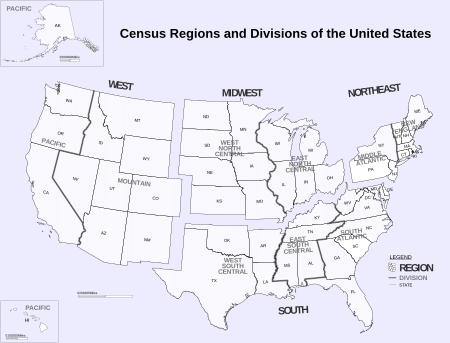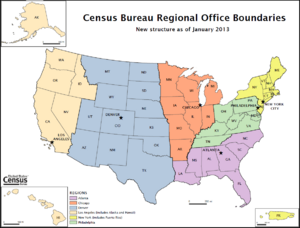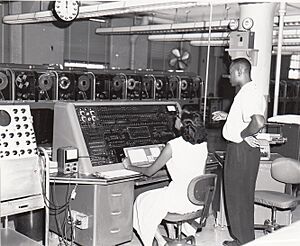United States Census Bureau facts for kids
 |
|
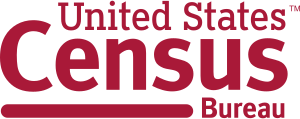 |
|
| Agency overview | |
|---|---|
| Formed | July 1, 1902 |
| Preceding agency |
|
| Headquarters | 4600 Silver Hill Road, Suitland, Maryland, U.S. (Washington, D.C. mailing address) |
| Annual budget | $1.382 b United States dollar/USD |
| Agency executives |
|
| Parent agency | U.S. Department of Commerce |
The United States Census Bureau (USCB) is a key part of the U.S. government. Its main job is to collect information about people and the economy in the United States. The Census Bureau is part of the U.S. Department of Commerce. Its leader, called the Director, is chosen by the President of the United States. Right now, Rob Santos is the Director, and Dr. Ron Jarmin is the Deputy Director.
The most important task of the Census Bureau is to conduct the U.S. census every ten years. This count helps decide how many representatives each state gets in the U.S. House of Representatives. The information gathered also helps decide how over $675 billion in government money is shared each year. This money helps build and maintain schools, hospitals, roads, and police and fire departments.
Besides the big count every ten years, the Census Bureau does more than 130 other surveys and programs each year. These include the American Community Survey and the U.S. Economic Census. The Economic Census happens every five years. It collects facts about American businesses and the economy. This helps businesses make smart plans.
Contents
Why the Census Bureau is Important
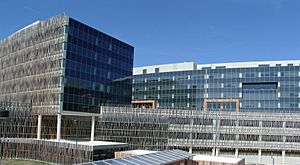
The Article One of the United States Constitution says that the U.S. government must count its population at least once every ten years. This count helps decide how many members each state has in the House of Representatives. It also affects the Electoral College, which is how the president is elected. The Census Bureau does a full count every ten years in years ending with a zero. This is called the "decennial" census. Between these big counts, the Bureau also estimates population numbers.
Census data directly affects how billions of dollars in federal and state money are given to communities. This money is used for things like improving neighborhoods, public health, education, and transportation. The Census Bureau is required by law to collect these statistics about the nation, its people, and its economy. These rules are found in Title 13 of the United States Code.
The Census Bureau also does surveys for other government groups. These surveys cover topics like jobs, crime, health, how people spend money, and housing. These are called "demographic surveys." They are done all the time, even between the big ten-year counts. The Bureau also surveys businesses like factories, stores, and service providers.
From 1790 to 1840, local marshals did the census. In 1840, a central office was created, which became the Census Office. In 1902, this office moved under the Department of Interior. In 1903, it was named the Census Bureau and became part of the new Department of Commerce and Labor.
By law, the Census Bureau must count everyone. It must give the total population numbers for each state to the U.S. president by December 31 of any year ending in a zero. States then get these results in the spring of the next year.
How the Census Bureau Collects Data
Census Regions and Divisions
The U.S. Census Bureau divides the country into four main regions and nine smaller divisions. These regions are widely used for collecting and studying data. The District of Columbia is included, but U.S. territories are not.
Here are the regions and divisions the Census Bureau uses:
- Region 1: Northeast
- Division 1: New England (Connecticut, Maine, Massachusetts, New Hampshire, Rhode Island, Vermont)
- Division 2: Mid-Atlantic (New Jersey, New York, Pennsylvania)
- Region 2: Midwest (Before 1984, this was called the North Central Region.)
- Division 3: East North Central (Illinois, Indiana, Michigan, Ohio, Wisconsin)
- Division 4: West North Central (Iowa, Kansas, Minnesota, Missouri, Nebraska, North Dakota, South Dakota)
- Region 3: South
- Division 5: South Atlantic (Delaware, District of Columbia, Florida, Georgia, Maryland, North Carolina, South Carolina, Virginia, West Virginia)
- Division 6: East South Central (Alabama, Kentucky, Mississippi, Tennessee)
- Division 7: West South Central (Arkansas, Louisiana, Oklahoma, Texas)
- Region 4: West
History of Regions
The current system of regions started with the 1910 census. Before that, the Census Bureau used different ways to group states. Over time, minor changes were made, like adding new states as they joined the U.S. and renaming the North Central region to Midwest in 1984.
How Census Data is Used
Many governments, from federal to local, use census data for important decisions:
- Deciding where to build new homes and public places.
- Understanding the characteristics of communities and states.
- Planning transportation systems and roads.
- Setting up police and fire districts.
- Creating local areas for elections, schools, and utilities.
- Gathering population information every 10 years.
Census data helps decide how seats in Congress are given to states. It is also used to estimate the current U.S. and World Population. This estimate includes people living in the 50 states and Washington, D.C.
Keeping Your Information Private
The U.S. Census Bureau promises to keep all personal information private. Title 13 of the U.S. Code sets strict rules and penalties for sharing this information. All census employees must promise not to share any data they collect. Breaking this promise can lead to a large fine or prison time.
The Bureau cannot share your answers, addresses, or personal details with anyone. This includes other U.S. government agencies like the IRS or the FBI. They also cannot share it with foreign governments. The Census Bureau's main job is to provide good data while protecting everyone's privacy. Information collected is only made public after 72 years. This time frame was chosen because most people who participated would likely no longer be alive.
In the past, there were times when the Census Bureau shared information with other government agencies. For example, during World War II, some neighborhood information about Japanese-Americans was shared. This was denied for many years but was proven in 2007. Today, the rules are very strict to prevent such issues.
Census data is very important for how political power is shared across the country. Because so much is at stake, the census can sometimes become a topic of political discussion. This can make it tricky to get clear results, especially when counting different groups of people. The Census Bureau works hard to make sure its data is accurate and fair for everyone.
Since the 1980s, the Census Bureau has used new technology to make data collection better. They created a system called TIGER (Topologically Integrated Geographic Encoding and Referencing). This system helps them map and organize information more accurately. TIGER data is also available to the public. It helps combine population facts with geographic information for better analysis.
In 2020, the Census Bureau changed how it shares data. It stopped using its old platform, American FactFinder, and now uses data.census.gov.
Ongoing Surveys
Between the big ten-year censuses, the Bureau does many surveys. These surveys give a general and detailed look at social and economic conditions in the U.S. Field representatives collect information from homes about jobs, spending, health, housing, and other topics.
Surveys done between the decennial censuses:
- American Community Survey
- American Housing Survey
- Consumer Expenditure Survey
- Census of Governments
- Current Population Survey
- Economic Census
- National Ambulatory Medical Care Survey
- National Health Interview Survey
- National Hospital Care Survey
- National Hospital Ambulatory Medical Care Survey
- National Crime Victimization Survey
- National Nursing Home Survey
- Survey of Income and Program Participation
- Survey of Construction
- Survey of Market Absorption
- Survey of Program Dynamics
- National Longitudinal Survey
- National Survey of Fishing, Hunting, & Wildlife-Associated Recreation
- Residential Finance Survey
- National Epidemiologic Survey of Alcohol Related Conditions
- Annual Retail Trade Survey
- Annual Wholesale Trade Survey
- Annual and Quarterly Services Surveys
Other Surveys Conducted
The Census Bureau also collects information for other government groups. These include the Bureau of Justice Statistics (BJS), the Department of Housing and Urban Development (HUD), and the National Science Foundation (NSF).
How the Census Bureau is Organized
Since 1903, the Census Bureau has been the official agency for counting the U.S. population. It is led by a Director, who gets help from a Deputy Director and other leaders.
The main office of the Census Bureau has been in Suitland, Maryland, since 1942. A new building was finished there in 2007, supporting over 4,000 employees. The Bureau has regional offices in six cities: New York City, Philadelphia, Chicago, Atlanta, Denver, and Los Angeles. There is also a National Processing Center in Jeffersonville, Indiana. For the ten-year census, many temporary offices open up, and over a million people are hired.
In 2013, the Census Bureau combined its twelve regional offices into six. This was done to save money and use new tools like laptops for surveys. The offices in Boston, Charlotte, Dallas, Detroit, Kansas City, and Seattle were closed.
The Census Bureau also works with the Census Information Center program. This program includes 58 non-profit groups that help represent communities that might be hard to reach.
Technology Used by the Census Bureau
The 1890 census was the first to use electric machines to count data. These were invented by Herman Hollerith. In 1951, the Census Bureau started using one of the first computers, a UNIVAC I.
Handheld Computers
In the past, census takers went door-to-door with paper forms. Starting in 1970, forms were mailed. To save paper and money, and to get a complete list of addresses, the 2010 census used 500,000 special handheld computers. These devices were used for the first time in 2009 to check addresses. This was expected to save over $1 billion.
Security Measures
These handheld computers were made by Harris Corporation. They had a fingerprint scanner to make sure only the right person could use them. They also had GPS to help manage addresses and send information. Keeping people's private information safe was a top priority.
Success and Challenges
Some census takers had problems with the devices, especially in rural areas where cell phone signals were weak. This made it hard to send data. However, overall, the use of these devices was a big step forward for the census.
Research and Improvement
The Census Bureau always does research to make its work better. Researchers study how to improve surveys, how many people participate, and how accurate the data is. They look at things like undercounts (missing people) or overcounts (counting people more than once). They also explore using new technologies and ways to lower costs. Before surveys are sent out, they are tested. After they are done, they are reviewed to see what worked well.
Notable People Who Worked at the Census Bureau
- John Shaw Billings
- Rattan Chand
- W. Edwards Deming
- Davis Rich Dewey
- Halbert L. Dunn
- Murray Feshbach
- Robert Groves
- Henry Gannett
- Morris H. Hansen
- Joseph Adna Hill
- Herman Hollerith
- Leslie Kish
- John Wesley Langley
- Bernard Malamud
- Thomas Commerford Martin
- Warren Mitofsky
- Ivan Petrof
- Cyrus Guernsey Pringle
- Richard M. Scammon
- Thelma Strabel
- Howard Sutherland
See also
 In Spanish: Oficina del Censo de los Estados Unidos para niños
In Spanish: Oficina del Censo de los Estados Unidos para niños
- List of U.S. states and territories by population
- List of metropolitan statistical areas
- List of United States cities by population
- List of United States counties and county equivalents
- United States Office of Management and Budget
- Primary statistical area (list)
- Combined statistical area (list)
- Core-based statistical area (list)
- Metropolitan statistical area (list)
- Micropolitan statistical area (list)
- List of United States urban areas
- Title 13 of the United States Code
- Title 15 of the Code of Federal Regulations
- Director of the United States Census Bureau
- Data.gov
- USAFacts
- Statistical Abstract of the United States


